
We pitted the heavyweight supplement brands against each other in our 2020 supplements report.
In the report, we produced both a winners & losers table.
MyProtein’s visibility rose by 205% (a winner 😊) while Huel’s dropped by -80%. (a loser 😢).
Today, we look at each brands website to understand what is right and what is wrong.
It’s important to note that despite Huel being a ‘loser’, they’re still doing plenty of things correct from a digital perspective.
Huel’s Strong Suits:
In spite of a visibility drop off, their website is far from average. They ranked 4th in our brand reach table, demonstrating a strong social following and brand searches.
See here are the positives Huel can take away:
Backlinks
They’re picking up authoritative backlinks for days, and that has to be applauded. While the figure is dwarfed by MyProtein, 1.8k backlinks aren’t to be sniffed at. Of course, link quality is just as important as quantity, and they’ve picked up some notable links, including over 200 links from domains rated 70+ DA.
Cultivating Brand Visibility
Huel is a well-known brand. Amassing 11,000 brand searches per month, they do stellar work on social. The fitness industry is visual, and Huel offers up inspirational images featuring their branded products. They also link to their Instagram and Twitter accounts, encouraging engagement when on the platform.
These are all signposted on the main website well and drum up a brand identity that many brands would be jealous of.
Interactive Forum
Huel signpost a forum in their nav. Forums are huge in this sector. This platform is a great way to capture repeat customers (bodybilding.com are the OG’s of this).
Give people the chance to engage, learn, and enter conversations on your platform and traffic will increase. There is live chat and shared tips between a community cultivated by Huel.
The page picks up organic traffic and is an effective driver of customer engagement.
Educational Content
Huel does a good job servicing the intent of the varying customers their products attract. Fitness is big business, with everyone from amateurs to seasoned veterans shopping for supplements.
If you’re a beginner, you’re likely to need a helping hand. At the top of Huel is a banner linking to a ‘learn more’ page. This page gives the reader an introduction to hitting their goals and answers basic questions like ‘how many calories do I need’. Educating new customers from the jump assures the uninitiated that they’re in the right place.
MyProtein Vs Huel
There’s no getting away from the fact that MyProtein trumped Huel in our report. Put the two side by side, and there are glaring differences…
Demonstrating Expertise – The Homepage and More
MyProtein has trust-building embedded into their homepage, from quoting themselves as the “Worlds No.1 Online Sports Nutrition Brand” to Trustpilot & sport accreditation badges in the footer.
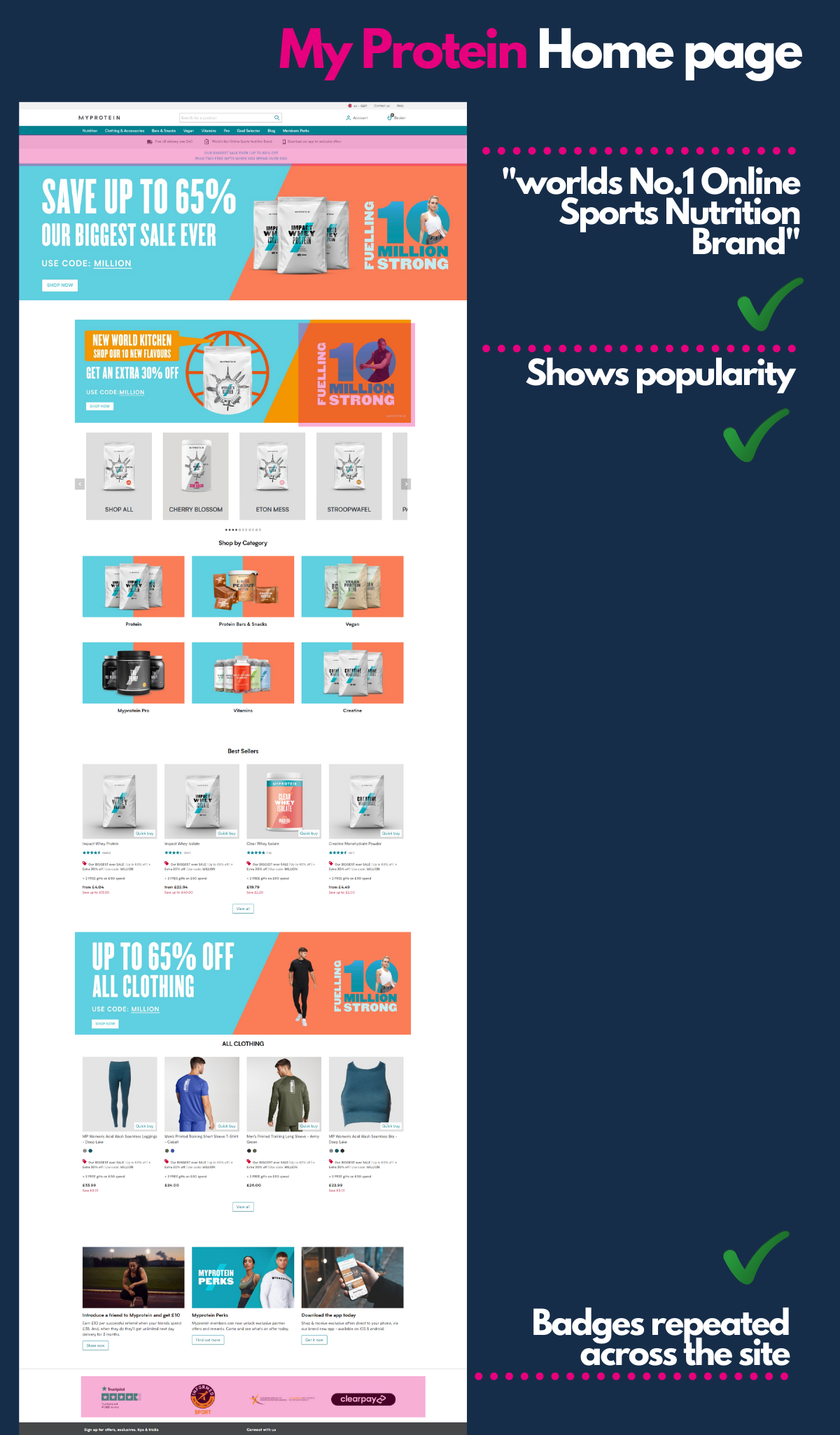
Additionally, viewing Myprotein’s quality assurance page, you’re immediately met with re-assurance.
You’re left with no doubt as to the legitimacy and reputation of the brand from the get-go.
Myprotein utilises videos, breaking down the quality of their products. Since its launch on April 21st, the highlighted video below has been viewed 4,394 times.
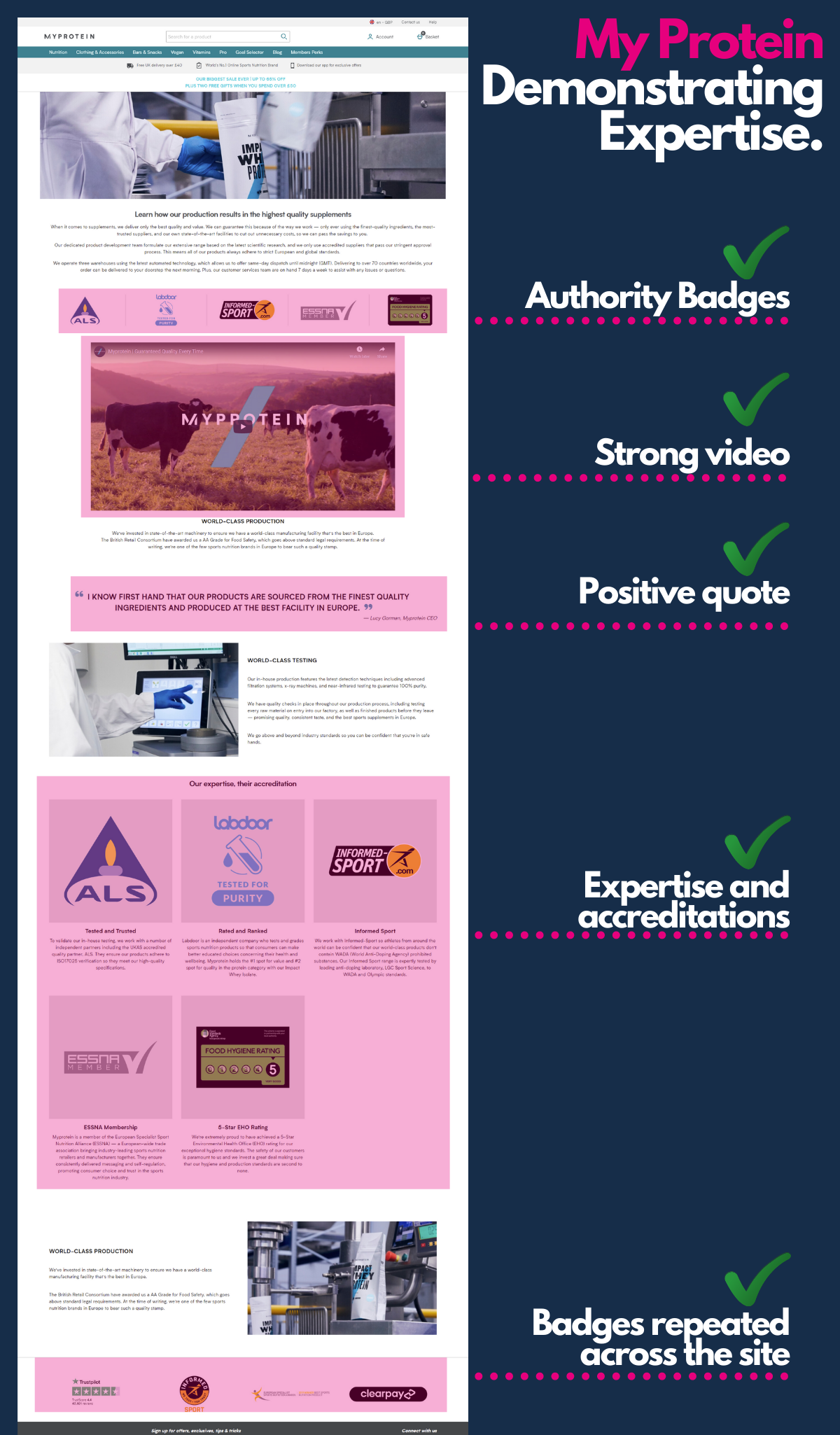
Huel has no such dedicated page.
Huel lacks third party approval in the form of accreditation & trust pilot badges. However, they may well make up for this with approval quotes from experts.
Huel has minimal review info across the site and they don’t immediately showcase their reviews on product pages.
Product Page Content
Myprotein’s product pages do a good job of showcasing reviews, answering relevant ‘what is…’ ‘the benefits of…’ questions. They don’t give any irrelevant information, choosing to delve into further depth in guide content. As such, their product pages alone rank for a wide range of keywords. They also offer links to accompanying products to further drive sales.
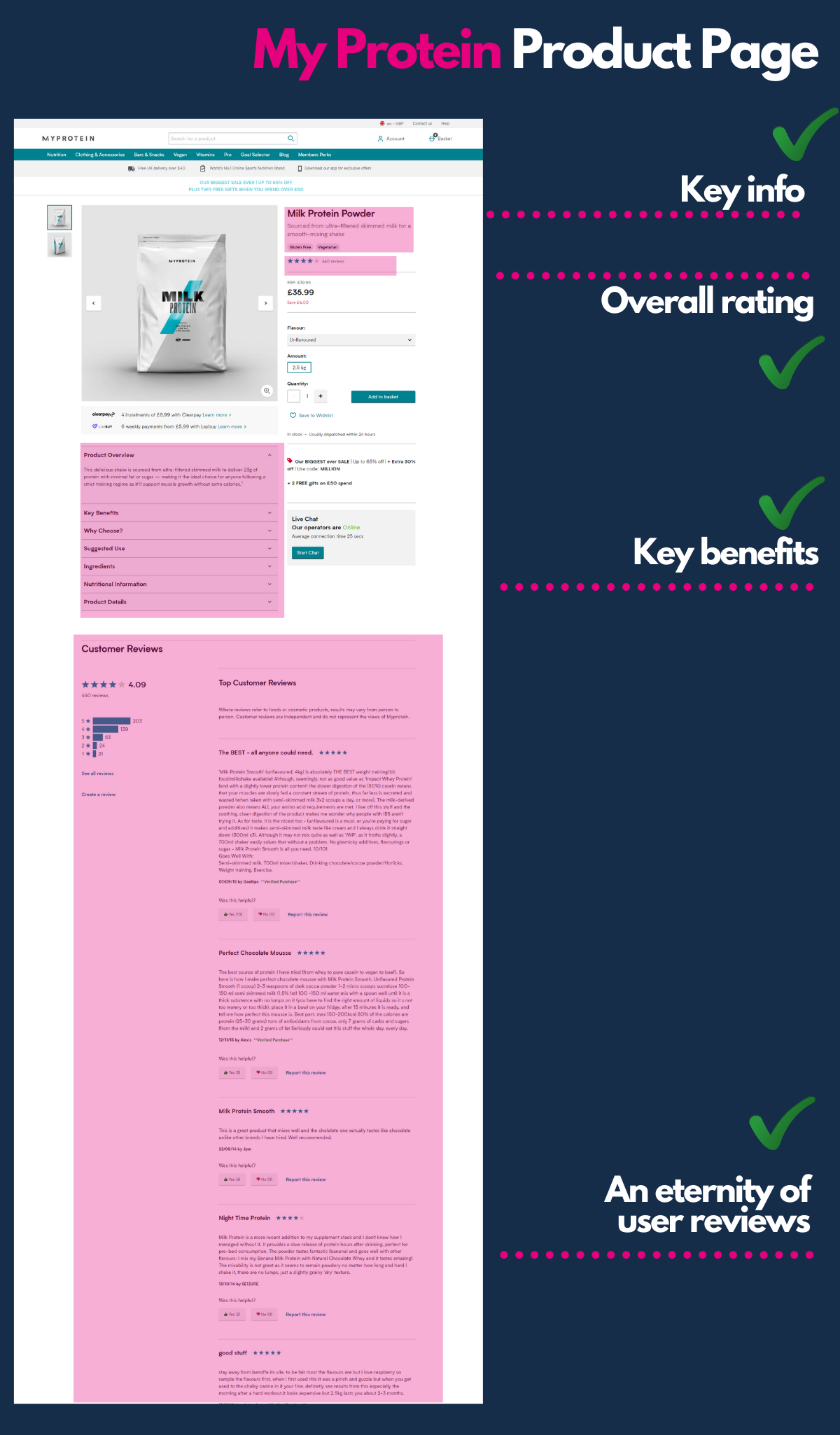
While Huel does have a section for answering questions on their product pages, there are cannibalisation issues there. They answer multiple questions which are repeated elsewhere on the site, including other product pages. Myprotein’s use of questions is far more effective and relevant to the stage of the buyer journey the page is for.
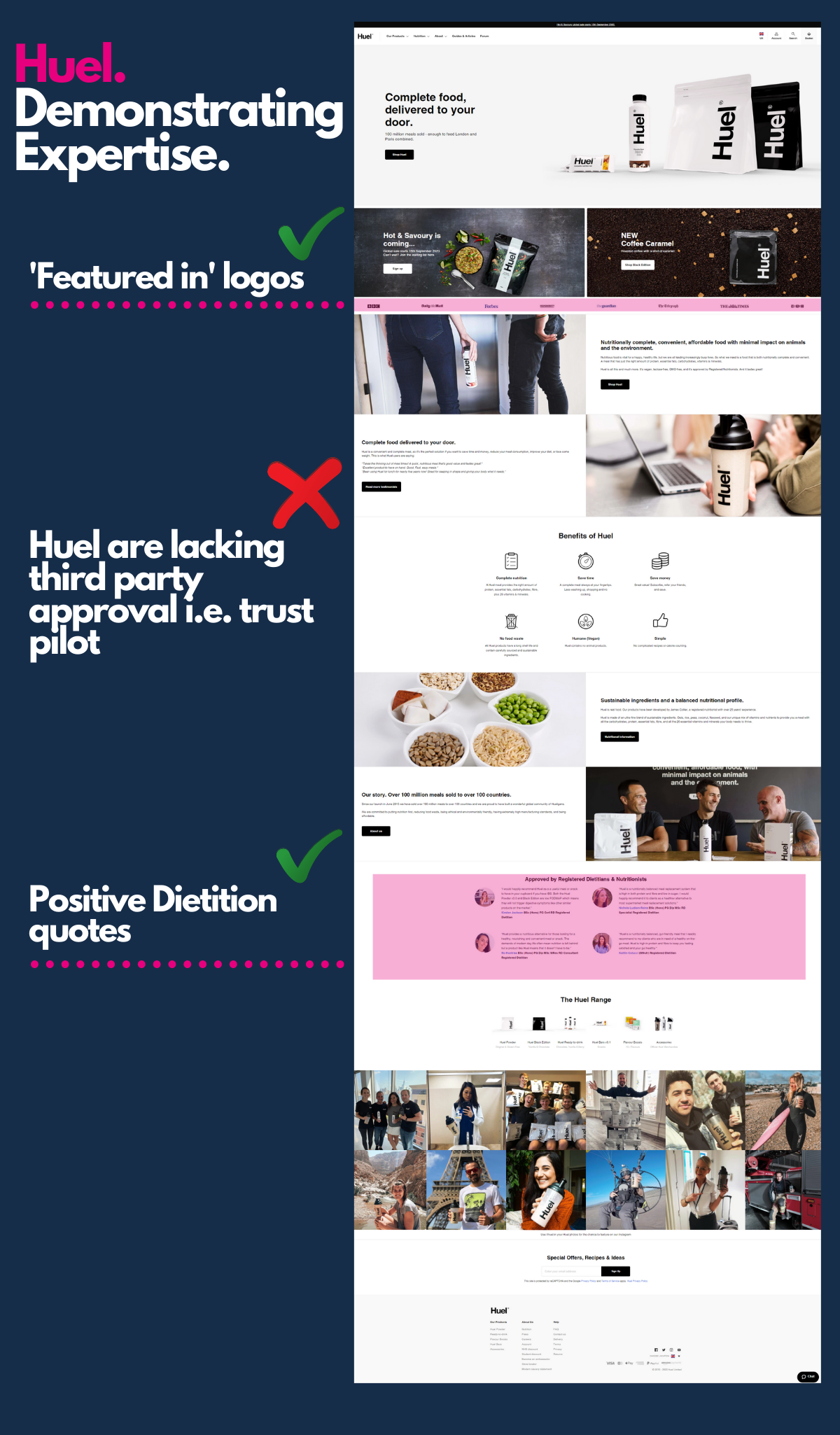
Huel does have their reviews displayed on product pages, although they’re tucked near the bottom of the page. Additionally, they’re not product-specific. Myprotein includes star ratings in their product titles, spotlighting them immediately.
Enhanced Category Page Content
Adding enhanced copy to category pages is a common tactic to make that category page rank for your desired keywords. Typically, a page will feature top copy introducing the page and headings which serve intent below the product links. Myprotein does this well, Huel not so much.
Myprotein’s pages feature the above tactics as well as relevant internal links. Huel, on the other hand, don’t utilise the functionality for category content at all. Myprotein target relevant keywords well on their category pages, which makes them rank. For example, the Protein Powder category ranks in position 1 for ‘protein powder UK’ and ‘whey protein uk’, while ranking for 836 keywords altogether.
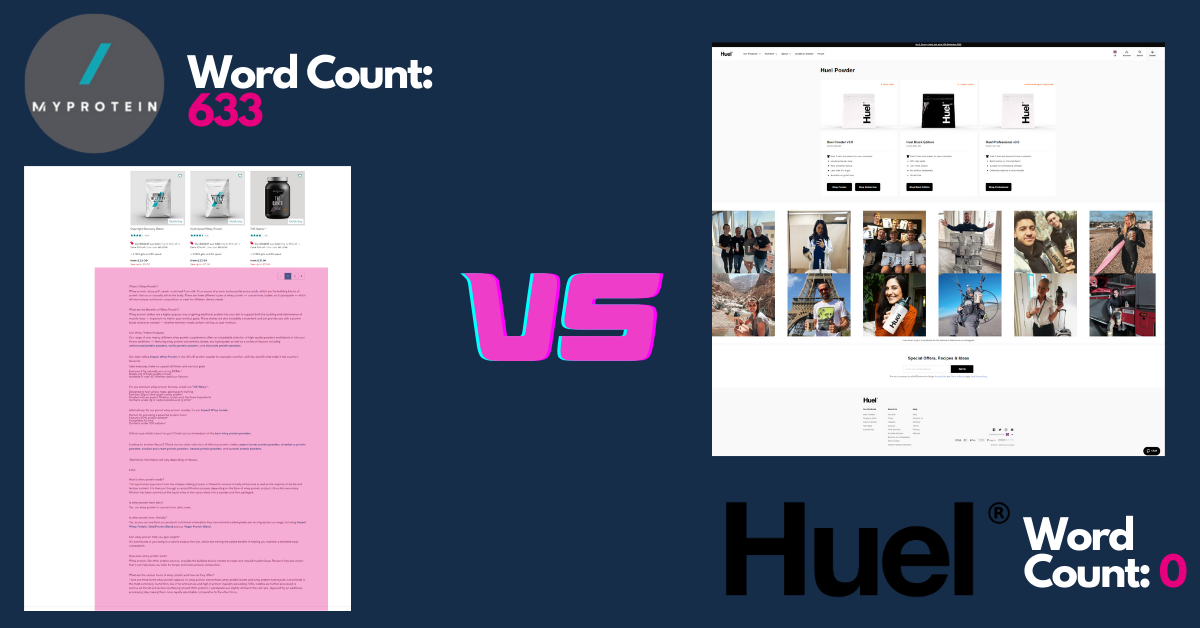
Huel’s categories aren’t split up into product types, rather branded products. As such, the categories suffer somewhat in the SERPs. For example, the Huel Powder category only ranks for 88 keywords, ranking nowhere for the term ‘protein powder’.
Informational Guides
Informational content is extremely useful when it comes to building authority, as well as backlinks. These guides also help to point customers in the right direction, targeting long-tail opportunities to direct searchers to commercial pages.
Myprotein has a substantial depth of high-quality content. Any question related to fitness is answered here. From workout routines to dietary information, they give fitness fanatics a reliable and useful library of content. High value informational keywords are nabbed here, such as – how many protein shakes a day (2.8k) p1, post-workout meal at night (2.7k) p2, what does l-carnitine do (1.3k) p9, what is insulin (4.6k) p13 etc.



Huel does have guides on their site, but the depth and quality of the content are night and day to that offered by Myprotein. Furthermore, the design of their blog gateway page is unappealing and doesn’t segment the content into clearly signposted categories. Myprotein breaks theirs up into categories (fitness, supplements, nutrition etc).
Deep Range Of Categories To Target Wider Keywords
Myprotein goes above and beyond to get their customers onto the right pages. Under the ‘nutrition’ banner alone, there is a range of clickable category links which segment the customer experience and appeal to a wide range of keywords. Elsewhere on the site, there are pages such as ‘back to the gym?’ ‘training essentials’ and other dedicated pages for each of their offerings.
As an example, head terms targeted in the nutrition drop down have sizable search volume – protein powder (32k), vitamins and minerals (2.3k), weight management (900), pre-workout (500) etc.

Huel has far fewer pages and targets fewer keywords through its main category pages. While it may be down to a limited product range, there are still other avenues they could go down to target searcher intent better.

Author Bios
In the post-EAT online space, putting a face to the information you’re providing is crucial. As both sites offer guide content which provides nutritional advice, these trust signals tell search engines that the information is legitimate and comes from a trustworthy source. Mypotein does this well, Huel less so.
You’re introduced to Myproteins editorial team on the home page of the blog. Authors are also signposted below the heading of articles, with clickable links to dedicated author pages. Huel, by comparison, makes no reference to the writer of their articles and provides no information to indicate the expertise of their writers.


Their author bios feature pictures of the writers, paragraphs detailing their experience and interests, before finishing off with a link to their LinkedIn page. Having this external link is a further indication of legitimacy.

Myprotein leaves Huel in their wake when it comes to these trust signals.


Goal Selector
Myprotein do a great job of understanding their customer base and guiding them on their purchase journey. Given the product type, it’s likely that customers have specific goals in mind when shopping for supplements. Their goal selector function is highly effective and captures the intent of visitors perfectly. By comparison, Huel has no such feature on their site.
Mens weight loss (200 searches /mo), female weight loss (300 searches /mo), mens muscle building, get lean (200 searches /mo), build muscle (800 searches /mo), workout goals (700 searches /mo). These are just a drop in the ocean of the wide range of keywords with notable search volume which are available for targeting here. This helps Myprotein to funnel these searchers to commercial pages. What’s more, by appealing to intent and specific goals, there’s less chance of a bounce, as the customer is sent to a page which perfectly matches what they’re looking for. Huel relies on pre-existing customer knowledge and potentially miss out on organic visitors looking for specific goals.



Once you eventually reach the final page, you’re met with shoppable links, further information links through to product pages and links to advice content and guides. This is another effective way of creating a top-notch linking profile throughout the site.

Summary
MyProtein’s strategies offer up plenty of food for thought, as do Huel’s good and bad points. Take heed of the do’s and don’ts when giving your site a facelift and you won’t go far wrong. Of course, we’re talking established brands who are big players in the game here. This is a mere surface-level look at both sites – a closer look under the hood is sure to rear plenty more pros and cons of both. That’s where Salience excels at doing the heavy lifting.
If you enjoyed this read why not follow us on LinkedIn?
If you feel like you’ve reached digital enlightenment, how about sharing it? Spread the love and all that…
